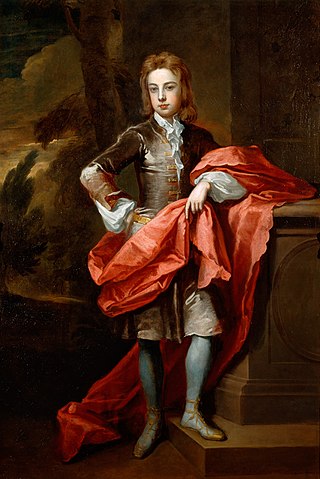
Allen Bathurst, 1st Earl Bathurst,, of Bathurst in the County of Sussex, known as The Lord Bathurst from 1712 to 1772, was a British Tory politician. Bathurst sat in the English and British House of Commons from 1705 until 1712 and then in the British House of Lords until his death in 1775, after being raised to the peerage as Baron Bathurst.

Nether Lypiatt Manor is a compact, neo-Classical manor house in the mainly rural parish of Thrupp, near Stroud in Gloucestershire, England. It was formerly the country home of Prince and Princess Michael of Kent and is a Grade I listed building.
Cirencester was a parliamentary constituency in Gloucestershire. From 1571 until 1885, it was a parliamentary borough, which returned two Member of Parliament (MPs) to the House of Commons of the Parliament of the United Kingdom until 1868, and one member between 1868 and 1885. In 1885 the borough was abolished but the name was transferred to the county constituency in which it stood; this constituency was abolished for the 1918 general election.

James Vernon the Younger was a British government official, courtier, diplomat and Whig politician who sat in the House of Commons from 1708 to 1710. He was an envoy to Denmark from 1702 to 1707.
John Freame (1669–1745) was an English goldsmith and banker. In 1690 he co-founded Freame & Gould, which later became Barclays Bank.
Thomas Master, of Cirencester Abbey, Wiltshire, was an English Tory politician who sat in the House of Commons from 1712 to 1747.
John Snell, of Gloucester, was an English lawyer and politician who sat in the House of Commons from 1713 to 1726.
Benjamin Bathurst FRS of Lydney, Gloucestershire, was an English politician who sat in the House of Commons for 54 years from 1713 to 1767.
Montague Garrard Drake (1692–1728), of Shardeloes, near Amersham, Buckinghamshire was a British Tory politician who sat in the House of Commons between 1713 and 1728.
Sir Richard Grobham Howe, 3rd Baronet (c. 1651–1730), of Little Compton, Withington and Chedworth, Gloucestershire, and Great Wishford, Wiltshire, was an English landowner and Tory politician who sat in the English and British House of Commons between 1679 and 1727.

Henry Seymour later Portman, of Orchard Portman, Somerset, was an English politician who sat in the House of Commons of England and then Great Britain almost continually between 1679 and 1715.
John Codrington, of Codrington, Gloucestershire and Wraxall, Somerset, was an English Tory politician who sat in the House of Commons between 1710 and 1741.
Sir Nathaniel Napier, 3rd Baronet, of Moor Crichel, Dorset, was an English landowner and politician who sat in the English House of Commons from 1695 to 1708 and in the British House of Commons from 1710 to 1722.
Henry Ireton, of Williamstrip, Gloucestershire, was an English Army officer, landowner and Whig politician who sat in the English and British House of Commons between 1698 and 1711.
Peter Bathurst, of Greatworth, Northamptonshire and Clarendon Park, near Salisbury, Wiltshire, was a British landowner and Tory politician who sat in the House of Commons between 1711 and 1741.

John Coxe of Nether Lypiatt, Gloucestershire was an English landowner and Member of Parliament.

Sir John Guise, 3rd Baronet of Elmore Court, Gloucestershire was a British landowner and politician who sat in the House of Commons between 1705 and 1727.
William Johnson of Blackwall, Middlesex, and Mandeville's Manor, Sternfield, Aldeburgh, Suffolk, was an English merchant, shipbuilder and Tory politician who sat in the English and British House of Commons for 29 years from 1689 to 1718
Sir Robert Jenkinson, 2nd Baronet, of Walcot, Charlbury, Oxfordshire, and Hawkesbury, Gloucestershire, was an English landowner and Tory politician who sat in the English and British House of Commons between 1689 and 1710.
Kinard de la Bere was an English landowner and MP. He was the son of John de la Bere of Southam, Gloucestershire and Anne, daughter of John Stephens of Lypiatt, Gloucestershire. The various branches of his mother's family frequently represented Gloucestershire in parliament. In 1699 he married Hester, the daughter and co-heiress of John Neale of Nether Dean, Beds. Her sister Anne had married his mother's nephew Thomas Stephens, a Whig MP for Gloucestershire from 1713 until his death in 1720. At the general election in 1722 he was returned to sit for Gloucestershire through the influence of the Stephens. He served only one term and did not stand in the following election. He died childess and his estate was inherited by his nephew William Baghot, who assumed the name De la Bere.






